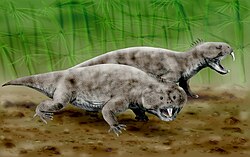| Pebbly Arkose | |
|---|---|
| Stratigraphic range: Carnian ~ | |
 Pebbly arkose outcrop, Ndepa hill, Kariba District, Zimbabwe | |
| Type | Geological formation |
| Unit of | Upper Karoo Group, Karoo Supergroup |
| Underlies | Forest Sandstone |
| Overlies | Escarpment Grit & Angwa Sandstone |
| Lithology | |
| Primary | Sandstone |
| Location | |
| Coordinates | 16°12′S30°18′E / 16.2°S 30.3°E |
| Approximate paleocoordinates | 50°48′S11°54′E / 50.8°S 11.9°E |
| Region | Mashonaland Central & West |
| Country | Botswana Zambia Zimbabwe |
| Type section | |
| Named for | Descriptive name |
| Named by | A.M. MacGregor, Zimbabwe Geological Survey |
The Pebbly Arkose Formation is a Late Triassic geologic formation found in southern Africa.



